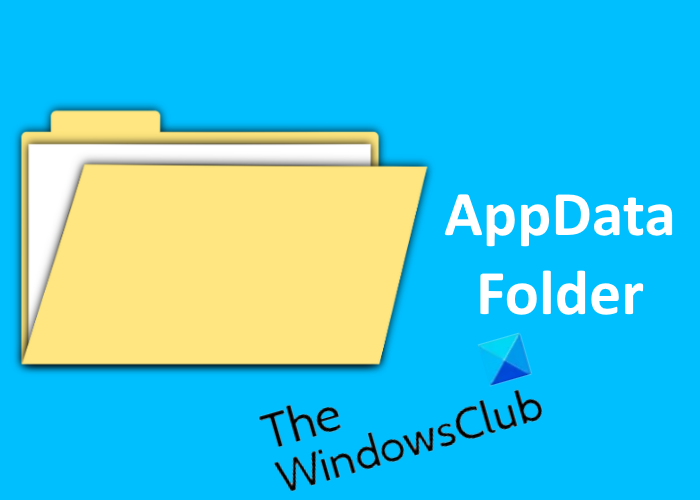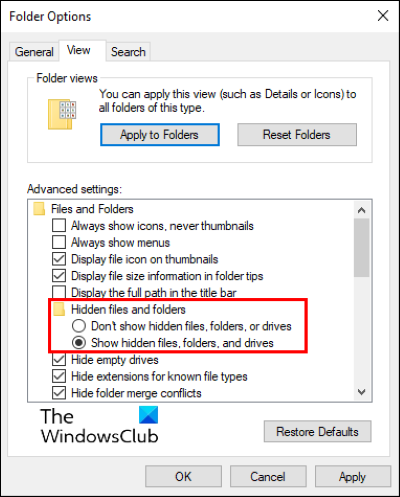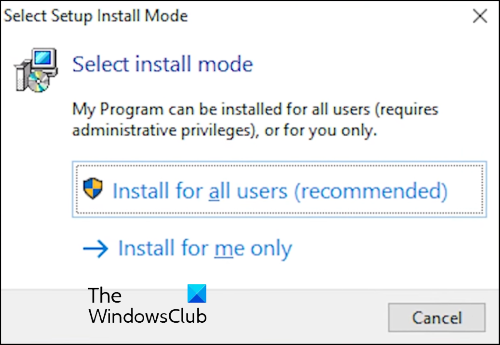When we install a program, it may go to either the Program Files folder or the Program Files x86 folder. Many of you might be aware of this fact. Every program has some customization features. When we run a program, we change its settings, customize its interface (if the feature is available), etc. This data is also stored on our computer’s hard disk inside the AppData folder. In this article, we will explain what the AppData folder is and how to find it.

Where is the AppData folder?
By default, the AppData folder is hidden in Windows computers. You cannot view it in the C drive of your system until you enable the Show hidden files and folder option.

Follow the steps to view the AppData folder on your system:
- Open the File Explorer.
- Go to “View > Options.” This will open the Folder Options window.
- Click on the View tab.
- Click the Show hidden files, folder, and drives option.
- Click on the Apply button and then OK to save the changes that you made.
Now, go to the following path:
C:\Users\<username>
Replace <username> in the above path with your username on your computer. There, you will find the AppData folder.
When you open the AppData folder, you will find three subfolders there, namely, Local, LocalLow, and Roaming. All these three subfolders are created for different purposes, which have been explained in that post.
In short:
- ProgramData folder contains global application data that is not user-specific and is available to all users on the computer. Any global data is put in here.
- AppData folder contains user-specific preferences and profile configurations and is further divided into three subfolders:
- Roaming folder contains data that can move with the user profile from a computer to a computer
- Local folder contains data that cannot move with your user profile.
- LocalLow folder includes low-level access data, eg. temporary files of your browser when running in a protected mode.
What is the AppData folder in Windows 11/10?
AppData folder is also called the Application Data folder. As the name implies, it is the folder in a Windows computer where the data that programs use or create is stored. The AppData folder’s data is not part of the original installation files.
It is located at:
C:\Users\<username>\AppData
You can also type %AppData% in the Run box to access the AppData\Roaming folder.
When you install a program, all the files required to run it go into the Program Files or Program Files x86 folder, and the data other than these files go into the AppData folder. This data includes:
- Program cache,
- Temporary files,
- Configuration files, etc.
You might be wondering why Windows uses a separate AppData folder to store the app data and files instead of keeping them in one place in the Program Files or Program Files x86 folder. Well, storing the app data in a separate folder has several advantages.
- Easy to manage user data: If you create multiple accounts on your system, Windows will create a separate AppData folder for each user. This makes it easy to manage the user settings for a particular app. For example, if a particular user changes settings or customizes an app, the data is stored in his own AppData directory and the other users’ profiles remain unaffected for the same program.
- Security: A separate AppData folder is also more secure because one user cannot access another user’s AppData folder.
- Prevent data from being messed up: Because every user has a separate AppData folder, the settings and other data of one user are not messed up with the other user’s data.
- No access to the Program Files or the Program Files x86 folder: The Program Files directory and the Users directory have different permissions. The former one is a higher level directory, hence, only the person with administrative rights can access the Program Files directory. If the app data were stored in the Program Files directory, users might have permission issues.
Some programs are installed in the AppData folder by default, and some ask your permission to do so. You might have installed the programs asking whether you want to install it for all users or only for you.
If you select the Install only for me option, the program will be installed, and the application installs into a user directory. If you choose For everybody, it’s a hint for the installer to install the program in global locations.

This post will help you if you cannot find or open the AppData folder.
Where can I find AppData in Windows 11?
The AppData folder is located at the following location on your C drive:
C:\Users\username\AppData
In the above path, replace the username with your user name. Copy the above path and paste it into the address bar of your File Explorer. After that, hit Enter. This will automatically open the AppData folder. Alternatively, you can also open the AppData folder by typing the following command in the Run command box. After that, click OK.
%userprofile%
The above command will directly pen the user folder on your C drive, where you will see the AppData folder. By default, it is hidden on all Windows computers. Therefore, if you do not see the AppData folder in your user profile folder, you have to enable the hidden files and folders.
Can I delete the AppData folder in Windows 11?
The AppData folder contains the data of apps and software you install on your system. If you open it, you will find three folders. Mostly, the apps and software data is located inside the Roaming folder, which is located inside the AppData folder. When you uninstall an app, its data will also be deleted automatically from the AppData folder. If you delete the AppData folder, all your apps and software data will be erased, and you will experience errors and issues with installed apps and software. THis post will show you how to clean AppData folder in Windows safely.
We hope you find the article useful.
Read: What is WpSystem folder?
Related posts:
Leave a Reply